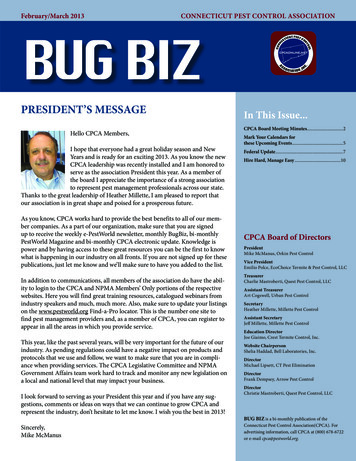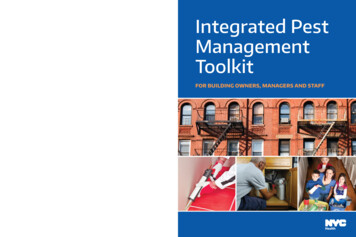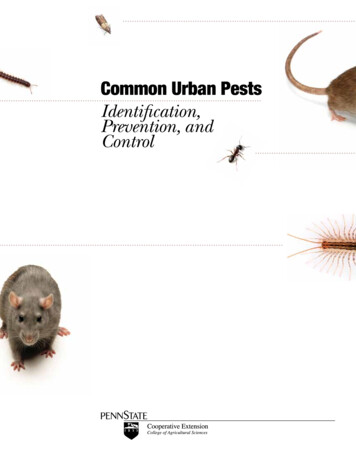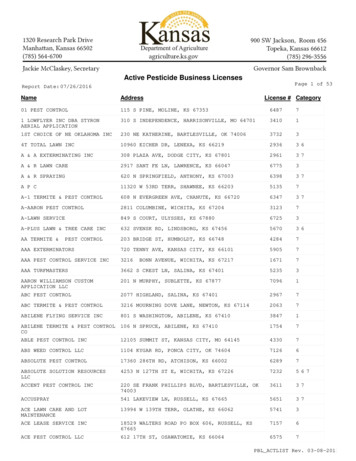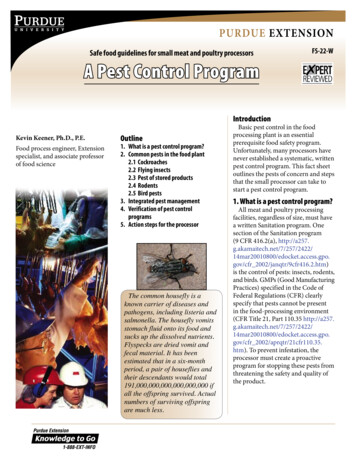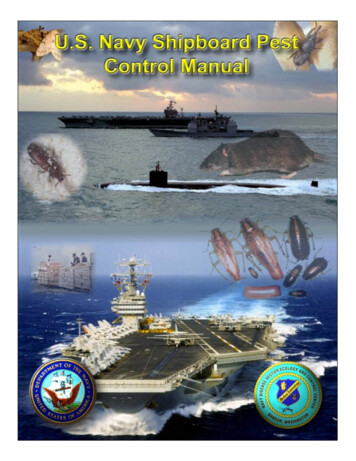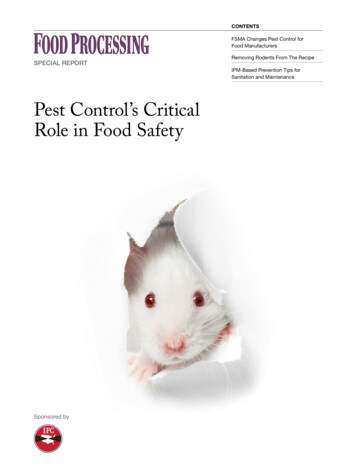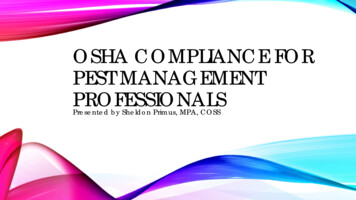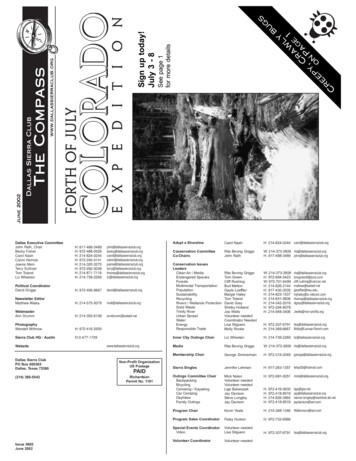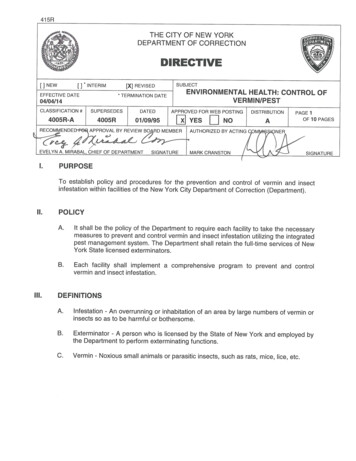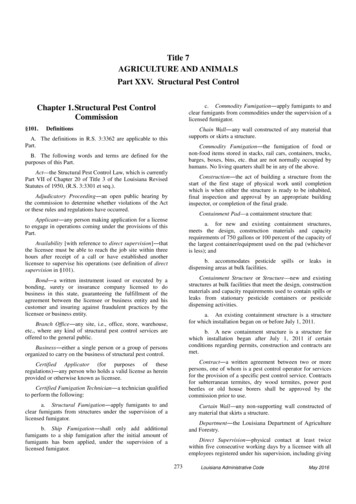
Transcription
Title 7AGRICULTURE AND ANIMALSPart XXV. Structural Pest Controlc. Commodity Fumigation―apply fumigants to andclear fumigants from commodities under the supervision of alicensed fumigator.Chapter 1. Structural Pest ControlCommission§101.DefinitionsChain Wall―any wall constructed of any material thatsupports or skirts a structure.A. The definitions in R.S. 3:3362 are applicable to thisPart.Commodity Fumigation―the fumigation of food ornon-food items stored in stacks, rail cars, containers, trucks,barges, boxes, bins, etc. that are not normally occupied byhumans. No living quarters shall be in any of the above.B. The following words and terms are defined for thepurposes of this Part.Act—the Structural Pest Control Law, which is currentlyPart VII of Chapter 20 of Title 3 of the Louisiana RevisedStatutes of 1950, (R.S. 3:3301 et seq.).Construction―the act of building a structure from thestart of the first stage of physical work until completionwhich is when either the structure is ready to be inhabited,final inspection and approval by an appropriate buildinginspector, or completion of the final grade.Adjudicatory Proceeding―an open public hearing bythe commission to determine whether violations of the Actor these rules and regulations have occurred.Containment Pad—a containment structure that:Applicant―any person making application for a licenseto engage in operations coming under the provisions of thisPart.a. for new and existing containment structures,meets the design, construction materials and capacityrequirements of 750 gallons or 100 percent of the capacity ofthe largest container/equipment used on the pad (whicheveris less); andAvailability [with reference to direct supervision]―thatthe licensee must be able to reach the job site within threehours after receipt of a call or have established anotherlicensee to supervise his operations (see definition of directsupervision in §101).b. accommodates pesticide spills or leaks indispensing areas at bulk facilities.Containment Structure or Structure—new and existingstructures at bulk facilities that meet the design, constructionmaterials and capacity requirements used to contain spills orleaks from stationary pesticide containers or pesticidedispensing activities.Bond―a written instrument issued or executed by abonding, surety or insurance company licensed to dobusiness in this state, guaranteeing the fulfillment of theagreement between the licensee or business entity and hiscustomer and insuring against fraudulent practices by thelicensee or business entity.a. An existing containment structure is a structurefor which installation began on or before July 1, 2011.Branch Office―any site, i.e., office, store, warehouse,etc., where any kind of structural pest control services areoffered to the general public.b. A new containment structure is a structure forwhich installation began after July 1, 2011 if certainconditions regarding permits, construction and contracts aremet.Business―either a single person or a group of personsorganized to carry on the business of structural pest control.Contract―a written agreement between two or morepersons, one of whom is a pest control operator for servicesfor the provision of a specific pest control service. Contractsfor subterranean termites, dry wood termites, power postbeetles or old house borers shall be approved by thecommission prior to use.Certified Applicator (for purposes of theseregulations)―any person who holds a valid license as hereinprovided or otherwise known as licensee.Certified Fumigation Technician―a technician qualifiedto perform the following:Curtain Wall any non-supporting wall constructed ofany material that skirts a structure.a. Structural Fumigation―apply fumigants to andclear fumigants from structures under the supervision of alicensed fumigator.Department―the Louisiana Department of Agricultureand Forestry.b. Ship Fumigation―shall only add additionalfumigants to a ship fumigation after the initial amount offumigants has been applied, under the supervision of alicensed fumigator.Direct Supervision―physical contact at least twicewithin five consecutive working days by a licensee with allemployees registered under his supervision, including giving273Louisiana Administrative CodeMay 2016
AGRICULTURE AND ANIMALSa. General Pest Control―the application ofremedial or preventive measures to control, prevent oreradicate household pests by use of pesticides used assprays, dusts, aerosols, thermal fogs, barriers, traps andbaits. Residential rodent control will be limited to the use ofanticoagulant rodenticide and traps;routine and/or special instructions, prescribing pesticides,calculating volume of pesticides to be applied, calibratingequipment and being available, whenever and whereverneeded, to handle any emergency situations which mightarise (see definition of availability in §101).Director―the director of the Division of Pesticide andEnvironmental Programs or his duly authorizedrepresentatives acting at his direction.b. Commercial Vertebrate Control―the applicationof remedial or preventive measures to control, prevent oreradicate vertebrates, including baits, chemicals, barriers,gases and traps, in nonresidential establishments, but notincluding tarpaulin fumigation;Division—the Department’s Division of Pesticide andEnvironmental Programs.Employee―any person employed by a permittee andworking under the supervision of licensee with theexceptions of clerical, janitorial or office maintenanceemployees or those employees performing work completelydisassociated with the use of pesticides, the control andinspection of insects, pests, rodents and the control of andinspection for wood-destroying insects.c. Termite Control―the application of remedial orpreventive measures for the control, prevention oreradication of termites and other wood-destroying insectsand the inspection of structures for wood-destroying insects;d. Fumigation―the use of lethal fumigants and/orrodenticides in a gaseous form for the control, prevention oreradication of insect pests, rodents, or other pests in a sealedenclosure with or without a tarpaulin;Fumigation―the application of a fumigant in residentialand commercial structures, ships, railcars, trucks,commodities such as dunnage on wharves, silos orconveyors, vaults or the like.e. Wood Destroying Insect Report (WDIR)Inspector―the application of remedial or preventivemeasures for the control, prevention or eradication oftermites and other wood-destroying insects and theinspection of structures for wood-destroying insects.Gas—matter in a vapor state which diffuses readily andis capable of indefinite expansion in all directions movingfrom an area of high concentration toward an area of lowerconcentration. Aerosols should not be confused with gas asthey are particulate suspensions.Licensee―the person who holds a valid license asherein provided.Material Safety Data Sheet (M.S.D.S.)―a documentwhich states chemical characteristics and safety precautionsregarding a specific chemical.Household Pest―all species of insects and other pestswhich infest residences and other types of buildings andtheir immediate premises, such as cockroaches, flies fleas,mosquitoes, clothes moths, spiders, carpenter ants, carpenterbees, rodents and so forth, but does not include wooddestroying insects.Non-Residential Establishment―includes, but shall notbe limited to, hotels, motels, schools, hospitals and nursinghomes.Hydraulic Injection—the non-trenching application of atermiticide mixture by high pressure into the soil.Permittee―any person who holds a place of businesspermit issued by the commission.Label―the written, printed or graphic matter on orattached to a pesticide or device or any of its containers orwrappers.Pest Control Operator—any person conducting orperforming structural pest control.Place of Business―the entire premises to which thepubic generally is expressly or impliedly invited for thepurpose of transacting business with the owner and is simplya location where business is transacted, or a shop, office,warehouse or commercial establishment, and shall beindicated on the application and the permit and any licenseissued for that place of business.Labeling―all labels and other written, printed orgraphic matter:a.accompanying a pesticide or device at any time;orb. to which reference is made on the label or inliterature accompanying the pesticide or device, providedthat the term does not apply to current official publicationsof the EPA; the U.S. Departments of Agriculture, Interior orHealth, Education and Welfare; state experiment stations;state agriculture colleges; and other similar federal and stateinstitutions and agencies authorized by law to conductresearch in the field of pesticides.Registered Employee―an employee registered asprovided by this Chapter.Registered Wood Destroying Insect Report (WDIR)Technician―an employee qualified to conduct wooddestroying insect report inspections.Registration Certificate―a document issued by thecommission staff to a non-licensed employee of a businessengaged in structural pest control work.License―a document issued by the commission whichauthorizes the practice and/or supervision of one or morephases of structural pest control work as follows:Repellents―substances, not fumigants, under whatevername known, which may be toxic to insects and relatedLouisiana Administrative CodeMay 2016274
Title 7, Part XXVinto position. Borate treatments during any stage ofconstruction shall be considered a pre-constructiontreatment.pests, but generally employed because of their capacity forpreventing the entrance or attack of pests.Residential Structure—any structure, movable orimmovable, permanent or temporary, that is adapted for bothhuman residence and lodging whether occupied or not, suchas, single-family homes, multi-family, apartments,townhouses, condominiums, and/or co-ops but excludes anystructure built for the temporary residence of a human suchas hotels, motels.b. New-Construction Treatment—a termiticidetreatment made with any commission approvedtermiticide(s) or baiting system that meets minimumspecification requirements for that type of treatment andwhich is applied or installed during or after the stage ofconstruction where a slab or concrete is poured or piers arebeing built or placed into position and up to 12 months aftercompletion of construction. New-construction treatments areto be made in accordance with the post-constructiontreatment section of termiticide labels.Rule as defined in R.S. 49:951(6).Secretary or Secretary of the Commission―the assistantcommissioner of Agricultural and Environmental Sciences(assistant commissioner).c. Post-Construction Treatment a termiticidetreatment made with any commission approvedtermiticide(s), using the post construction section of a label,which is applied after the time frame of new-construction.Ship Fumigation―the fumigation of a vessel capable oftransporting or housing people and/or products. It isnormally self-powered and shall have a crew or livingquarters.Vertebrate―those pests, such as rodents, bats and birds,belonging to the phylum vertebrata.Spot Treatment (when used in reference to termitecontrol work)―a localized application of chemicals or othersubstances to control, prevent or eradicate termites in aresidence or other structure that is not under a currentcontract.Violation―any act which is prohibited by the Act or anyof these rules and regulations. Violations shall be classifiedin accordance with degree of severity, as follows:a. Minor Violation―any act prohibited by the Actor these rules and regulations which does not result indanger to human health or damage to personal property,including, but not limited to, clerical errors or failure tomake timely reports to the commission;Structural Fumigation―the fumigation by covering orsealing churches, schools, homes or any other buildings inwhich people are normally housed or work or is frequentedby people. This also includes the covering or sealing ofsmall boats or ships under 100 feet.b. Moderate Violation―any act of negligence inmeeting the guarantees of an agreement for structural pestcontrol work in the licensure phase where the violationoccurs, such as failure to apply chemicals in accordance withlabel and labeling requirements and minimum specifications:Supervision—see definition of direct supervision in thisSection.Supplemental Treatment—when used in connection withtermite work, “supplemental treatment” means a localizedapplication of chemicals or other substances and/orplacement of baits to control, prevent or eradicate termites ina residence or other structure that is under a current contract.c. Major Violation―any act which may adverselyaffect human health and safety. Any act performed withouthaving the proper permit, license, or registration; anyintentional misrepresentation of any matter involved in orrelated to structural pest control work; or any false ormisleading statement knowingly make in a wood-destroyinginsect report or any failure to timely pay any civil penaltyimposed buy the commission or any failure to timely payany fee collected by the department.Termites―all species of the order Isoptera which infesttimbers and\or other materials containing cellulose inbuildings and\or contents thereof, subdivided into twogroups according to their habits, as follows:a. Subterranean Termites―all species of termiteswhich make tubes, but not pellets, and normally requirecontact with soil; especially species of the generareticulitermes and coptotermes;Wood Destroying Insect Report (WDIR)―a documentapproved by the Structural Pest Control Commission issuedby a pest control operator only for inspections made todetermine the presence of wood destroying insects for actsof sale or refinance of structures. A wood destroying insectreport shall not be renewable or issued for any otherpurpose.b. Dry-Wood Termites―all species of termiteswhich make pellets, but not tubes, and do not require contactwith damp soil; especially species of the genera kalotermes,cryptotermes an incisitermes.Termiticide―any substance applied to buildings, woodproducts or soil for the treatment of termites.AUTHORITY NOTE: Promulgated in accordance with R.S.3:3362 and R.S. 3:3366.HISTORICAL NOTE: Promulgated by the Department ofAgriculture, Structural Pest Control Commission, LR 11:323 (April1985), amended by the Department of Agriculture and Forestry,Structural Pest Control Commission LR 15:954 (November 1989),17:251 (March 1991), LR 23:855 (July 1997), LR 30:1143 (June2004), amended by the Department of Agriculture and Forestry,Termiticide Treatment—application of a termiticide.a. Pre-ConstructionTreatment—atermiticidetreatment for subterranean termites made with a commissionapproved termiticide prior to the stage of construction wherea slab or concrete is poured or piers are being built or placed275Louisiana Administrative CodeMay 2016
AGRICULTURE AND ANIMALSOffice of Agriculture and Environmental Sciences, LR 31:26(January 2005), amended by the Department of Agriculture andForestry, Structural Pest Control Commission, LR 32:796 (May2006), repromulgated LR 32:1015 (June 2006), amended LR 33:39(January 2007), LR 35:204 (February 2009), LR 35:1468 (August2009), LR 37:272 (January 2011), amended by the Department ofAgriculture and Forestry, Office of Agricultural and EnvironmentalSciences, Structural Pest Control Commission, LR 39:300(February 2013), LR 41:333 (February 2015), LR 42:213 (February2016).§103.N. There shall be no voting by proxy.O. Three members of the commission shall constitute aquorum, and no action shall be taken without three votes inaccord.P. Rules and regulations of the commission, andamendments thereto, shall be noticed, adopted andpromulgated as required by the Administrative ProcedureAct.Administration of the Affairs of theCommission; Adoption of Rules and RegulationsAUTHORITY NOTE: Promulgated in accordance with R.S.3:3363, R.S. 3:3364 and R.S. 3:3366.HISTORICAL NOTE: Promulgated by the Department ofAgriculture, Structural Pest Control Commission, LR 11:325 (April1985), amended by the Department of Agriculture and Forestry,Structural Pest Control Commission, LR 20:644 (June 1994), LR35:204 (February 2009), LR 37:275 (January 2011), amended bythe Department of Agriculture and Forestry, Office of Agriculturaland Environmental Sciences, Structural Pest Control Commission,LR 39:300 (February 2013).A. As provided by R.S. 3:3364, the commissioner or hisdesignee shall serve as permanent chairman of thecommission.B. The assistant commissioner shall serve as secretary ofthe commission.C. In the absence of the chairman, the secretary shallpreside at meetings of the commission.§105.D. The chairman shall designate a hearing officer, whomay or may not be a member of the commission, to presideat all adjudicatory proceedings of the commission.Permit for Operation of Structural Pest ControlBusiness; Changes in Structural Pest ControlBusinessA. Every place of business engaged in structural pestcontrol work shall:E. The commission shall serve as the hearing body in alladjudicatory proceedings and shall make the final decisionwith regard to the disposition of matters coming toadjudication.1. obtain a permit for operation from the commissionprior to engaging in structural pest control work.F. The commission shall hold regular meetings at leastonce during each quarter.2. provide a certificate of insurance on a documentprovided by the department including but not limited to thefollowing information:G. Meetings of the commission shall normally be held inthe domicile of the commission.a. not less than 250,000, general liability coverage,per occurrence for the following:H. Meetings may be held at locations other than thedomicile of the commission upon the determination of thechairman or at the written request of any three members ofthe commission.i.all work performed under specific structuralpest control license phases;b.damage;I. Special meetings of the commission may be called atany time by the chairman.J. Whenever at least three members of the commissiondesire to call a special meeting, the three members shall soadvise the chairman in writing and the chairman shall call aspecial meeting to be held within 30 days after receipt of themembers' request.or combined single limits of 350,000;d.definitions for purposes of this Section:i.Public Liability―general liability;ii.Accident―occurrence;3. Provide evidence of a surety or fidelity bond on aform provided by the department covering the business withwhich the applicant is connected, issued by a bonding, suretyor insurance company authorized to do business inLouisiana, in the amount of 2,000, of tenor and solvencysatisfactory to a majority of the commission. An applicantwho is not connected with a business covered by therequired surety or fidelity bond shall secure the appropriatecoverage prior to issuance of the license.L. The secretary shall notify each member of thecommission by in writing or by electronic means of anyregular or special meeting at least one week prior to themeeting date.M. The secretary shall provide clerical and other supportservices as may be required by the commission and shallmaintain and distribute appropriate minute records of allmeetings of the commission.May 2016c.e. provide at least 10 days prior written notice to thecommission before cancellation and 10 days written noticeto the commission when paid claims reach or exceed theaggregate limit.K. If the chairman fails or refuses to call a specialmeeting upon the proper request of three members, themembers may convene a special meeting of the commissionby written notice to the remaining members.Louisiana Administrative Codenot less than 100,000 coverage for property276
Title 7, Part XXVb. If all the wood destroying insects contracts arenot being sold or transferred then the information providedto the commission shall include:B. No permit for operation shall be issued by thecommission unless there is a licensee for each phase ofstructural pest control work being conducted who isdomiciled and designated as the primary licensee at thebusiness location for which the permit is sought.i.a statement that all wood destroying insectscontracts are being sold or transferred except for the specificcontracts listed;C. Each permit for operation shall be renewed annually,on or before June 30 of each year.ii.a list of the specific contracts that are not beingsold or transferred;D. The fee for issuance of a permit for operation shall be 150 for firms which employ two or less employees and 200 for firms which employ three or more employees.iii.for each contract being sold or transferred, astatement that all contracts being sold or transferred shallremain in full force and effect in accordance with the termsand conditions of the customers' contracts.E. When two or more businesses which are separatelegal entities, even though owned by the same individual orthe same legal entity, are operated at one physical location,each separate entity shall obtain a permit for operation.2. The person acquiring a wood destroying insectscontract by a sale or transfer shall notify the customer inwriting, within 30 days after the sale or transfer of:F. Whenever a license is suspended or revoked under§131, the commission may also revoke the permit to operate.In such cases, the commission shall recall the permit andrequire the licensee to immediately return the permit to thecommission.a. the effective date of the sale, transfer, or changein status; andb. the name, address, and telephone number of theperson acquiring the customer's wood destroying insectscontract;G. Whenever a permit is recalled by the commission asprovided in §105.F, no structural pest control work of anykind shall be provided by persons domiciled at the locationfor which the recalled permit has been issued.c. a statement that the customer's contract shallremain in full force and effect in accordance with the termsand conditions of the contract.H. Except as provided in this Subsection, any change inthe status of a permittee (e.g., death, retirement, prolongedillness, merger, sale, change of ownership, etc.) shall bereported to the commission, in writing, within 14 days afterthe change in status occurs.J. A permittee who is closing his business or isotherwise not going to honor or service existing wooddestroying insects contracts shall, within 14 days of the timeof the close of business or ceasing to honor or serviceexisting wood destroying insects contracts shall providecertified written notification of the decision to affectedcustomers along with the following information:1. If the change in the permittees status would resultin the non-renewal of the place of business permit or wouldrequire the commission to issue a new place of businesspermit, then the notice shall be accompanied by thefollowing information:1.the commission's address and telephone number;2. the date of closure or last date the contract will behonored or serviced;a. the reason for the change in the status and theeffective date of the change;3.b. the status of all licensee(s) and registered andcertified technicians;a statement of bond coverage; and4. the bond company's name, address, telephonenumber, and contact person.I. If a permittee sells or otherwise transfers any wooddestroying insects contract then the commission and eachcustomer whose contract was sold or transferred shallreceive the following written notification.K. Any person who fails to comply with the provisionsof this Section shall personally come before the commissionprior to that person being granted a registration, certification,license, or permit, or renewal thereof. The commission maydeny or defer action on a request to grant a registration,certification, license or permit, or renewal thereof. Thecommission may deny a renewal or impose civil penaltiesfor violation of this Section only after the person has beenbrought to an adjudicatory proceeding and found guilty ofviolating the provisions of this Section.1. The selling or transferring permittee and the personpurchasing or receiving the wood destroying insects contractshall each provide the commission in writing the followinginformation and statements.a. If all the wood destroying insects contracts of thepermittee selling or transferring such contracts are beingpurchased or transferred then a statement that all wooddestroying insects contracts are being sold or transferred andthat all the contracts shall remain in full force and effect inaccordance with the terms and conditions of the customers'contracts shall be sufficient.L. All information and all documents relating to writtencontracts transmitted to the commission in accordance withthe requirements of this Section shall be confidential andshall be exempt from the Public Records Law, R.S. 44:1 etseq., as provided in R.S. 3:3370(E).277Louisiana Administrative CodeMay 2016
AGRICULTURE AND ANIMALSAUTHORITY NOTE: Promulgated in accordance with R.S.3:3366 and R.S. 3:3374.HISTORICAL NOTE: Promulgated by the Department ofAgriculture, Structural Pest Control Commission, LR 11:325 (April1985), amended by the Department of Agriculture and Forestry,Structural Pest Control Commission, LR 15:954 (November 1989),LR 33:40 (January 2007), LR 37:275 (January 2011), amended bythe Department of Agriculture and Forestry, Office of Agriculturaland Environmental Sciences, Structural Pest Control Commission,LR 42:213 (February 2016).§107.state in the licensee phase for which the individual desiresto take the examinations and complete a commissionapproved comprehensive termite program. Experience withan out-of-state structural pest control operator shall besubstantiated by evidence acceptable to the commission.C. Each applicant for a ship fumigation license shallpossess one of the following qualifications in order to takethe examination:1. a degree from an accredited four-year college oruniversity with a major in entomology and 200 jobs in shipfumigation working under the supervision of a licensed shipfumigator; orLicense to Engage in Structural Pest ControlWork RequiredA. No person shall perform structural pest control workuntil licensed and permitted to do so by the commission.1. general pest control, commercial vertebrate controland fumigation:2. a degree from an accredited four-year college oruniversity with at least 12 semester hours or the equivalentin quarter hours of course work in entomology and at leastone year of experience as a registered technician under thesupervision of a licensee in ship fumigation; ora. a degree from an accredited four-year college oruniversity with a major in entomology; or3. four years of experience as a registered technicianunder the supervision of a licensee in ship fumigation; orb. a degree from an accredited four-year college oruniversity with at least 12 semester hours or the equivalentin quarter hours of course work in entomology and at leastone year of experience as a registered technician under thesupervision of a licensee in the licensee phase for which theapplicant desires to take the examination; or4. experience as a certified ship fumigation technicianhaving completed 200 jobs in ship fumigation workingunder the supervision of a licensed ship fumigator; orB. Each applicant for license shall possess one of thefollowing qualifications in order to take the examination(s):5. four years of experience as a technician under thesupervision of a structural pest control operator in anotherstate in ship fumigation. Experience with an out-of-statestructural pest control operator shall be substantiated byevidence acceptable to the commission; orc. four years of experience as a registeredtechnician under the supervision of a licensee in the licenseephase for which the applicant desires to take theexamination; or6. 200 jobs in ship fumigation that the applicant hasworked as a registered technician in ship fumigationworking under the supervision of a licensed ship fumigator,during a two-year period.d. four years of experience as a technician under thesupervision of a structural pest control operator in anotherstate in the licensee phase for which the individual desires totake the examinations. Experience with an out-of-statestructural pest control operator shall be substantiated byevidence acceptable to the commission;2.D. Each applicant for licensure shall also demonstratethe following competencies:1. knowledge of the practical and scientific factsunderlying the practice of structural pest control, control ofwood-destroying insects and/or fumigation; andtermite control:a. a degree from an accredited four-year college oruniversity with a major in entomology and complete acommission approved comprehensive termite program; or2. knowledge and ability to recognize and controlhazardous conditions which might affect human life orhealth.b. a degree from an accredited four-year college oruniversity with at least 12 semester hours or the equivalentin quarter hours of course work in entomology and at leastone year of experience as a registered technician under thesupervision of a licensee in the licensee phase for which theapplicant desires to take the examination and complete acommission approved comprehensive termite program; orE. Each applicant shall successfully complete theappropriate examination for certification prior to issuance ofthe structural pest control license.F. In addition to the qualifications required by §107.BC, each applicant for licensure must shall:1. submit a complete application for examination asrequired by §109 hereof;c. four years of experience as a registeredtechnician under the supervision of a licensee in the licenseephase for which the applicant desires to take the examinationand complete a commission approved comprehensivetermite program; or2. be approved by the commission to take theexamination for licensure;3. have successfully completed a written examinationfor licensure
Part XXV. Structural Pest Control Chapter 1. Structural Pest Control Commission §101. Definitions A. The definitions in R.S. 3:3362 are applicable to this Part. B. The following words and terms are defined for the purposes of this Part. Act —the Structural Pest Control Law, which is currentl y

